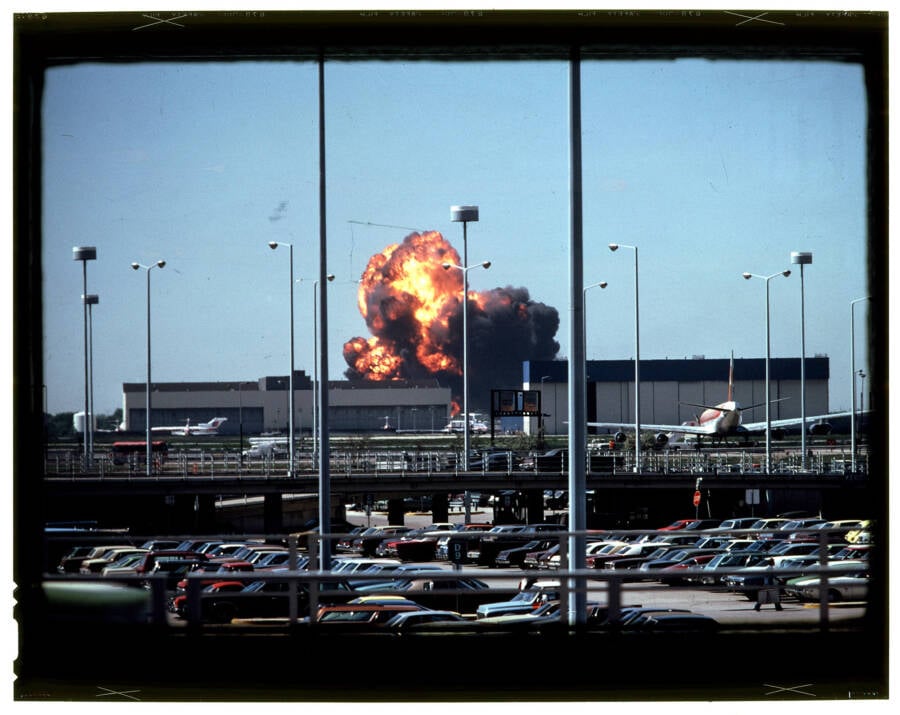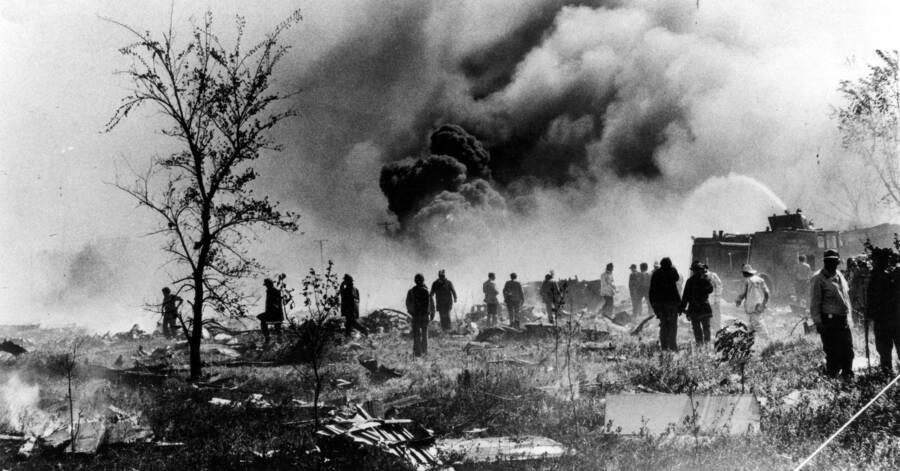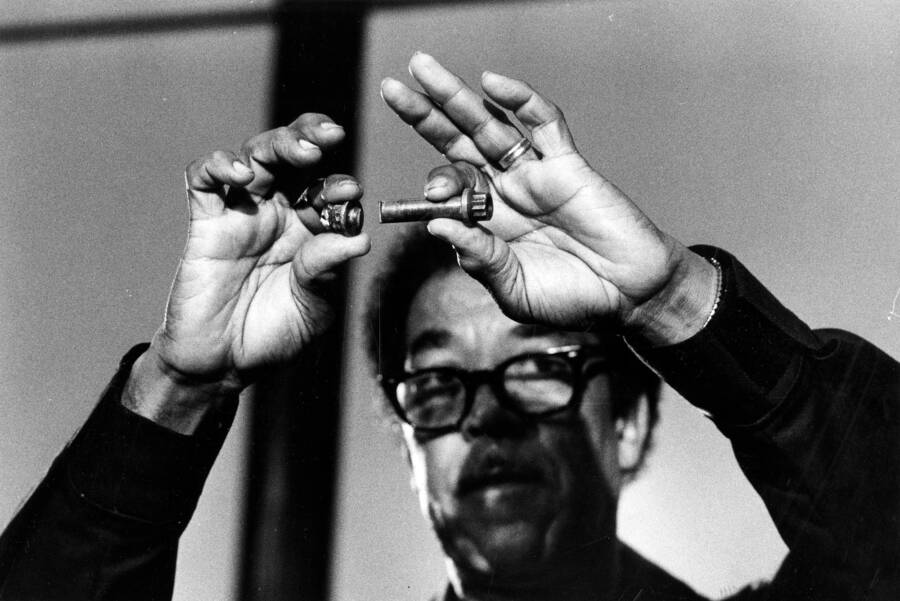In May 1979, American Airlines Flight 191 crashed just minutes after departing Chicago's O'Hare Airport, killing 273 people and sparking a wave of new airline safety regulations.

Tribune Content Agency LLC / Alamy Stock PhotoAmerican Airlines Flight 191 crashed in a burst of flames less than a mile away from the runway.
On May 25, 1979, a passenger flight from Chicago’s O’Hare International Airport to Los Angeles International Airport ended in disaster — not even a mile from the runway. American Airlines Flight 191 was the deadliest aviation accident in United States history, claiming a total of 273 lives: 13 crew members, 258 passengers, and two people on the ground.
The plane, a McDonnell Douglas DC-10, had been in operation for about seven years, with just around 20,000 miles logged in flight. But the airline hadn’t taken proper precautions to ensure the flight would safely reach its destination. And the consequences were catastrophic.
The American Airlines Flight 191 incident was not caused by an error on the pilot’s part, nor any collision with a foreign object. Rather, damage sustained during an earlier maintenance procedure caused a structural weakness, leading the left engine to break away during departure. As a result, the plane took off unbalanced, spiraled, and crashed in a blazing inferno.
Here’s what happened the day American Airlines Flight 191 crashed.
American Airlines Flight 191: The Deadliest Domestic Aviation Accident In American History
American Airlines Flight 191 was set to depart from Chicago O’Hare International Airport at about 3:00 p.m. on May 25, 1979. According to the Chicago Tribune, it was officially cleared for takeoff at 3:02 p.m., with 258 passengers and 13 crew members on board.
Runway 32R, from which Flight 191 would be departing, was a 10,000-foot stretch. Halfway to the end, at 5,000 feet, the plane reached the 175 miles per hour needed to take off. Then, its 9,000-pound left-wing engine and pylon broke free and crashed onto the runway.
“Damn,” one of the pilots said after hearing a loud thunk caused by the breakage. It was the last word caught on the cockpit voice recorder before the plane’s power cut off.
Unbeknownst to anyone on board, smoke was billowing out of the left wing, but the plane was too far along its takeoff to stop. At roughly 6,000 feet down the runway, it lifted into the air.

Tribune Content Agency LLC / Alamy Stock PhotoSmoke billowing out from the wreckage of American Airlines Flight 191.
The plane rose to a height of about 300 feet before it slowed down and dipped sharply to the left — and nosedived toward the ground.
American Airlines Flight 191 crashed into a field just under 5,000 feet from its departure point. The aircraft exploded in a fiery inferno as it hit the ground, leaving behind a burning wreck.
The time was 3:04 p.m.
The entire incident took place in a matter of two minutes. Not one person survived, and the victims’ bodies were so badly charred that they were unrecognizable.
Because lines of communication between the plane and air traffic control were severed shortly before the crash, much of what transpired onboard during the plane’s final moments remains a mystery.
What happened that could have caused the left-wing engine to break away like that? Could anything have prevented this terrible tragedy? These were the questions on people’s minds in the wake of the plane crash. And the unfortunate answer is that, yes, the situation could have easily been prevented.
What Caused American Airlines Flight 191 To Crash?
Shortly after the crash, the Federal Aviation Administration (FAA) conducted an investigation into the matter.
The investigation found that when the left engine and strut assembly separated from the plane, they damaged the hydraulic lines around the wing. This led to a loss of hydraulic pressure, causing the wing’s outboard leading edge slats to retract and sending the plane off balance as it lifted into the air.
Mechanics at various airlines were asked to inspect other McDonnell Douglas DC-10s to see if any other planes were facing similar issues.
As it turned out, they were.
Ernie Gigliotti, a United Airlines mechanic who inspected the DC-10s at O’Hare after the crash, told the Chicago Tribune, “I just had the feeling there was something not right” with the engine nose of another plane.

Tribune Content Agency LLC / Alamy Stock PhotoThe DC-10 left-wing engine lying just off the runway, where it skidded to a halt.
When he and his partner started to remove panels and look for signs of damage, they found numerous fractures and bolts with their heads sheared off.
Now another question arose: Was the blame to be placed on McDonnell Douglas’ manufacturing, or on American Airlines for not doing the proper upkeep?
Who Was To Blame For The Flight 191 Disaster?
According to the National Transportation Safety Board (NTSB), the blame fell on American Airlines.
McDonnell Douglas had specific maintenance procedures in place regarding the removal of the engine and the pylon connecting it to the wing during repairs. American, the investigation found, had failed to follow those instructions.
The instruction manual dictated that the engine should be removed before the pylon was detached, but American Airlines found that removing both at the same time saved them roughly 200 hours of labor per plane.
What’s more, when reattaching the engine, American workers had used a forklift, which was far less precise and could have caused damage to the engine.

Tribune Content Agency LLC / Alamy Stock PhotoElwood Driver of the NTSB shows a nut and bolt that broke on American Airlines Flight 191.
Both the FAA and NTSB made it abundantly clear that the pilots were not to blame for the crash. According to the FAA, the flight crew reacted appropriately for what they believed had been an engine failure, following the correct procedures.
Unfortunately, it wasn’t just that the engine had failed — it was gone.
The NTSB concluded that it simply wasn’t feasible for the pilots to have been able to deduce the problem and respond quickly enough to stop the plane from crashing. Again, the entire event took just two minutes.
Ultimately, American Airlines had stuck by the age-old adage, “time is money.” By taking some shortcuts during maintenance, they saved on time and accrued fewer expenses. The real cost came in the form of 273 human lives.
Following the plane crash, further regulations were put in place to ensure such an incident wouldn’t happen again — although there was some pushback.
How The American Flight 191 Crash Changed Air Travel
The NTSB report noted that both the airline and federal regulators had missed key signs that something could go wrong with Flight 191 and failed to act on them.
In fact, at the time, the FAA had argued that certain recommendations from the NTSB were unnecessary and too costly. It took the Flight 191 crash — and several other fatal incidents — before the FAA finally acquiesced.

Tribune Content Agency LLC / Alamy Stock PhotoFirefighters pull the remains of victims from the Flight 191 crash.
Over time, the accident helped inspire a slew of new airline safety measures, including updated technology, more in-depth training protocols, new maintenance procedures, and systems for flagging problems with aircraft.
Commercial air travel safety has greatly improved in the nearly 50 years since the crash of American Airlines Flight 191. Unfortunately, it took this tragic catalyst for these safety measures to be implemented.
After reading about the crash of American Airlines Flight 191, read about Mark Bingham, the 9/11 hero who led a revolt on Flight 93. Then, read the story of Jeff Skiles, the “Miracle on the Hudson” co-pilot who rescued US Airways Flight 1549.





